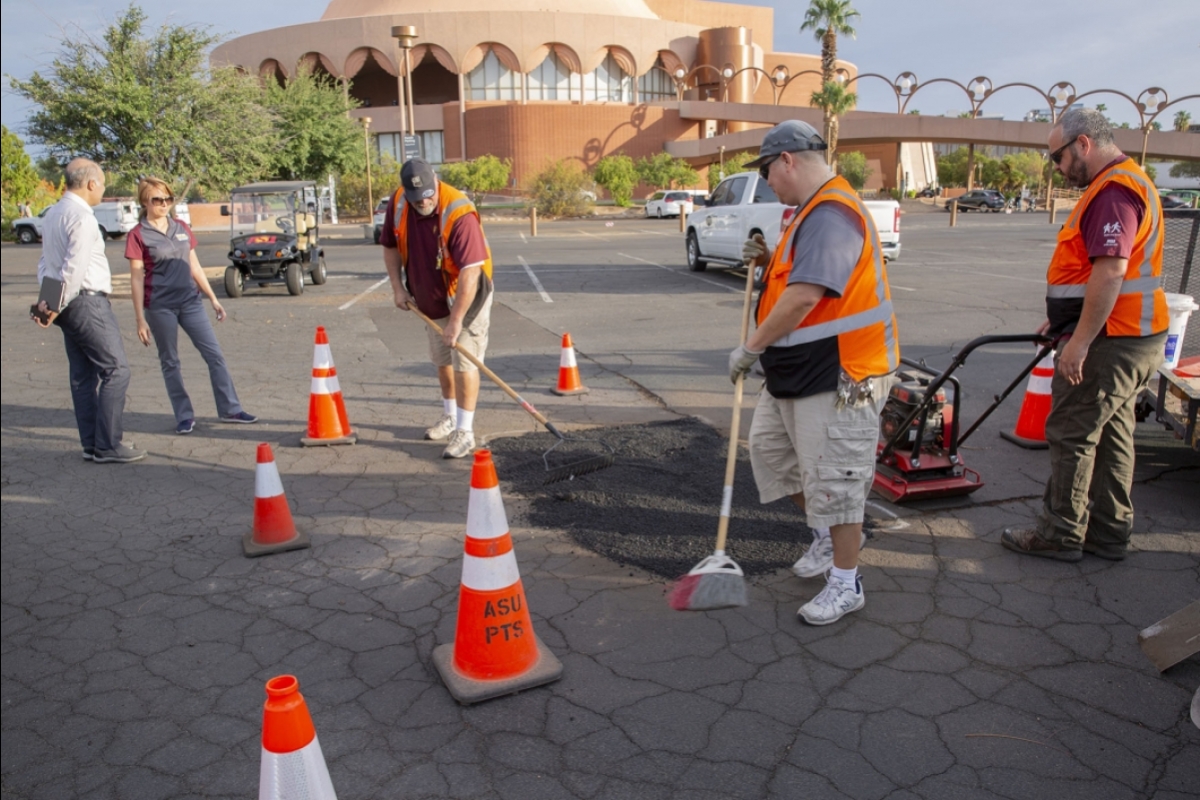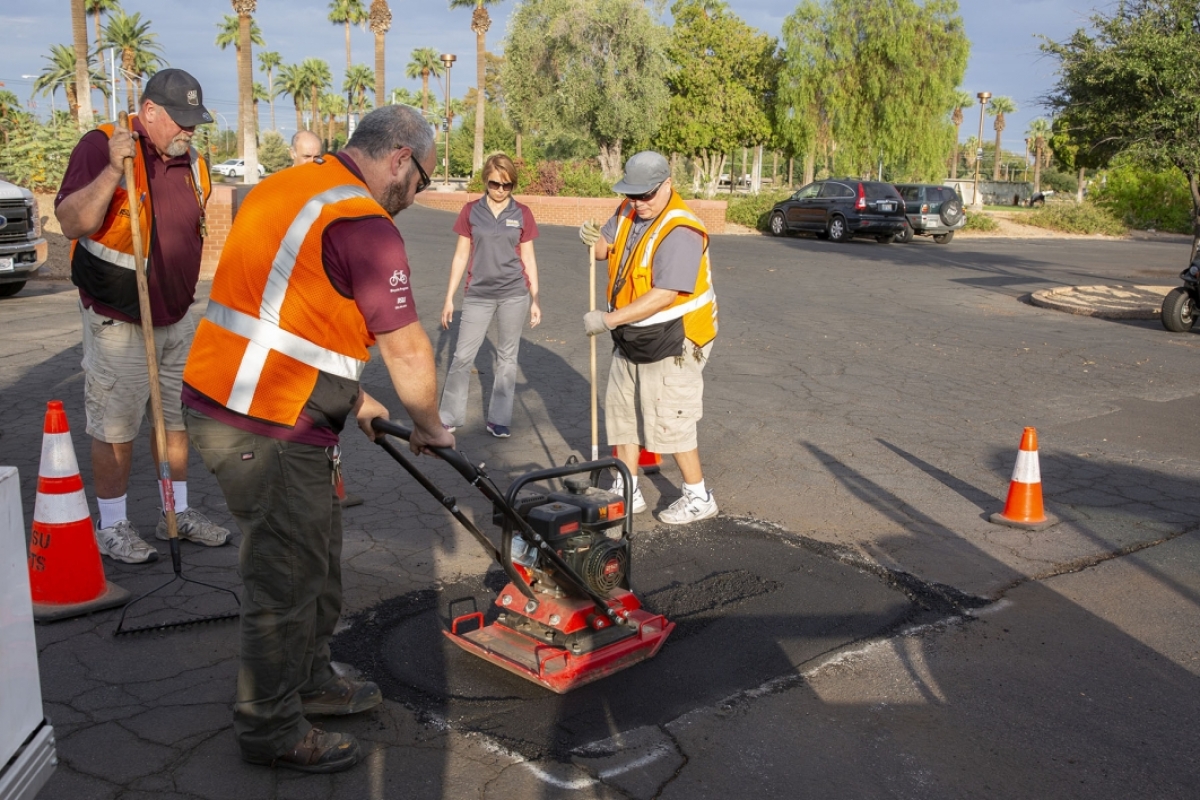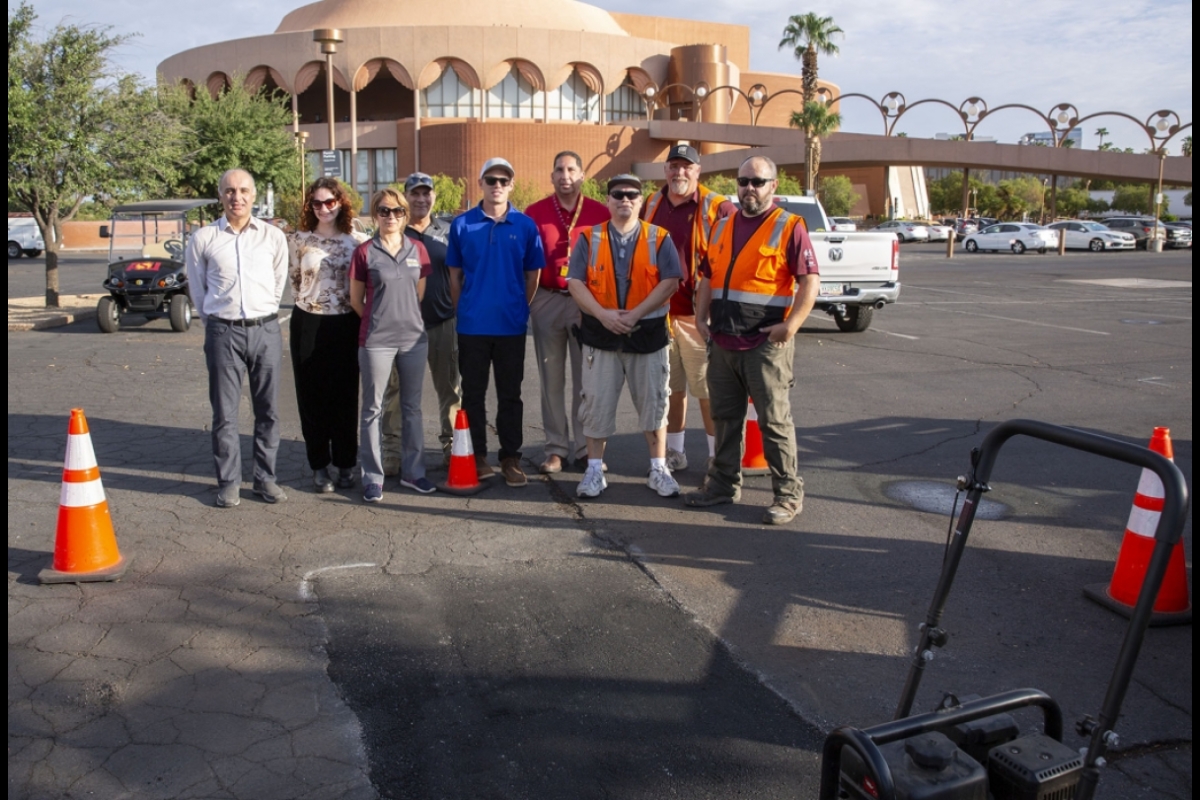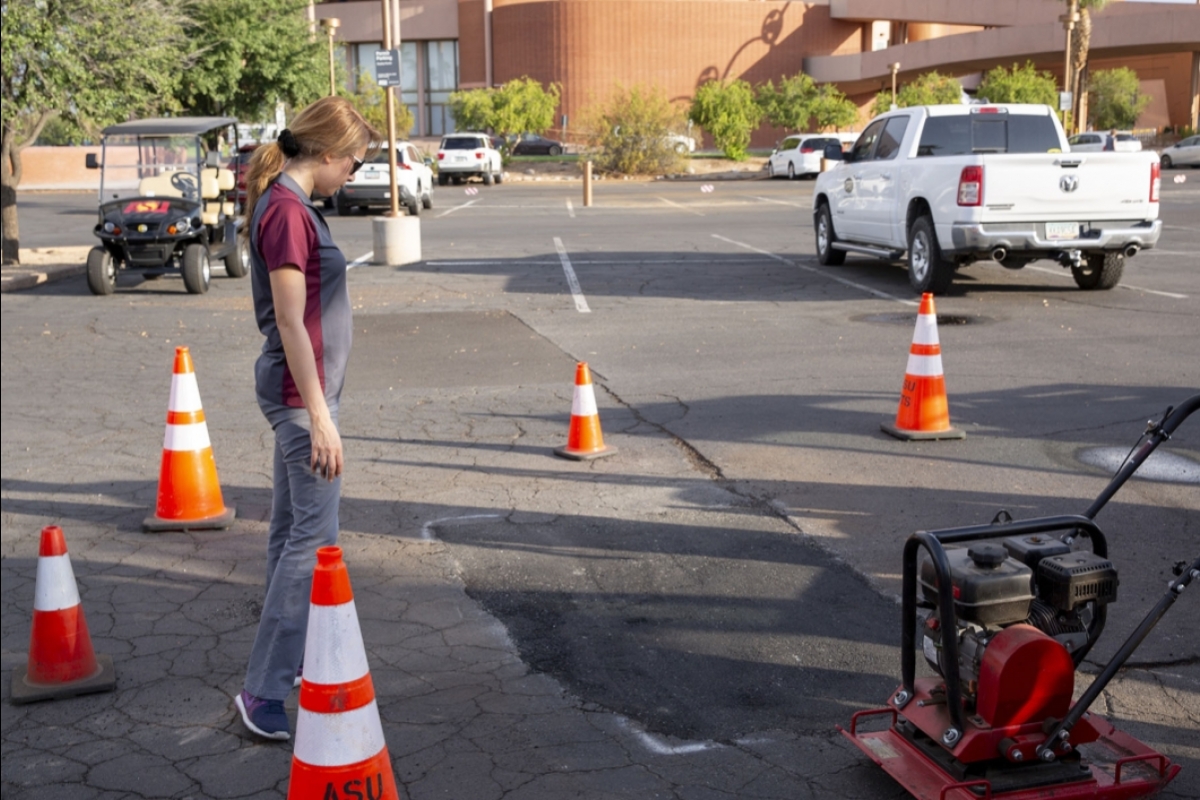New asphalt binder alternative is less toxic, more sustainable than conventional blend
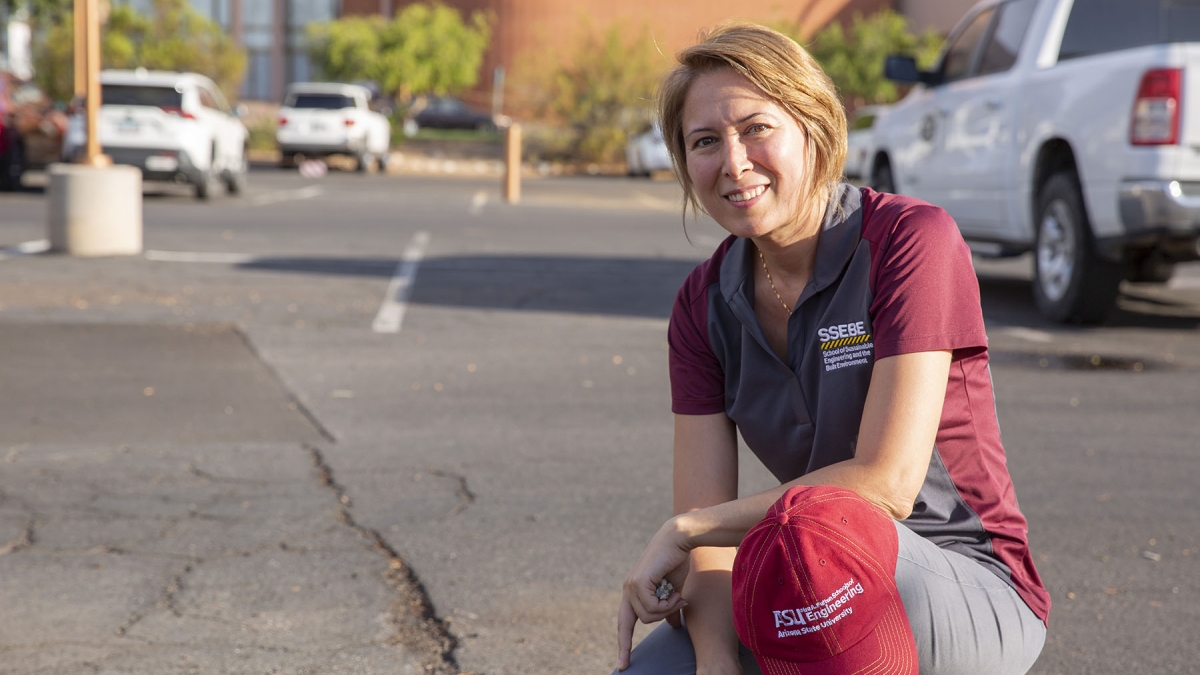
ASU’s Ellie Fini surveys the ASU Gammage Auditorium parking lot site where the first trial of AirDuo, a low-carbon asphalt binder, was used for a recent patch. AirDuo has the potential to be used for many asphalt paving processes, not just patches. Photo by Bobbi Ramirez/ASU
Asphalt is primarily known for use in roadways, but it's also used to pave playgrounds, bicycle paths, running tracks and tennis and basketball courts — all platforms for activities where breathing toxic fumes can be dangerous. Outdoor use on driveways, rooftops and parking lots, especially in the Arizona sun, also can lead to toxic fume exposure.
A team from Arizona State University, led by Associate Professor Ellie Fini in the School of Sustainable Engineering and the Built Environment (SSEBE), has developed AirDuo, a new, patent-pending asphalt binder that not only diminishes toxic fumes of the overall asphalt-surfaced area, but also increases sustainability.
But perhaps most importantly for Fini, it reduces health hazards for those exposed to asphalt-surfaced areas, especially for those performing the installation.
AirDuo's first local trial was initiated in late August as a patch in ASU's Gammage Auditorium parking lot. Frank Castro, associate director of Facility Maintenance, helped get the research out of the lab and into the parkig lot, facilitating the lab-to-market transition. On the morning of the install, the Parking and Transit Services team, led by Assistant Manager David Triana, completed the patchwork in a few hours.
Attendees of a theater production at Gammage the same night gave the patch a workout as they arrived and departed, and Castro reported to Fini the next day that the patch had “held up great.”
Fini envisions the new low-carbon, bio-based binder will ultimately be used for all asphalt paving products, not just patches.
The U.S. Department of Labor’s Occupational Safety and Health Administration notes that about a half-million workers annually are exposed to fumes from asphalt, with health effects that include headache, skin rash, fatigue, throat and eye irritation, cough and skin cancer.
Asphalt binder is the glue that holds together the stones, sand, gravel and other aggregates in asphalt pavements. The AirDuo binding mixture is composed of low-carbon, bio-based materials that are an alternative to more toxic petroleum products, also known as bitumen. Moreover, AirDuo acts as a toxicity filter for the overall product.
After the traditional blend of aggregates and binder is laid on the roadways, the stress from heat, sun, weather and traffic causes the release of breakdown products — molecules that vaporize — some of which are odorous, highly toxic or both.
“We breathe 11,000 liters of air per day,” Fini said. “But our nose isn’t smart enough to know when the air may be dangerous for our health. That new-car smell people like? That may not be good for your lungs. We run away from a smelly trash can, but the pleasant smell or fumes from certain materials can be far more toxic.”
Fini and Judith Klein-Seetharaman, a professor in both ASU’s College of Health Solutions and School of Molecular Sciences, collaborated to review literature about the health effects of various asphalt mixtures and mapped the effects on a network of biomarkers. Citing specific contaminants present in asphalt, the team discovered that all are not created equal and that different formulas have different levels of toxicity — the majority of which have not been studied comprehensively.
According to Klein-Seetharaman, there have not been sufficient studies of the long-term effects of asphalt-related toxins on the body.
“To give justice to the complexity of the problem, we need a systems-level view of the interactions between asphalt fume components and their biological targets,” Klein-Seetharaman said. "There are thousands of molecules present in asphalt, as well as thousands of biomolecular targets inside the human body that can bind to these molecules and respond to their presence with downstream biological effects, some of which can lead to adverse health outcomes.”
Fini has conducted ongoing research to investigate alternative asphalt binders, including a study on how iron-rich biochar absorbs volatile organic compounds from asphalt surfaces, and how it is both an eco-friendly and cost-effective alternative to bitumen components.
“When we use algae to make AirDuo, as we did from last year’s November harvest from ASU’s Center for Algae Technology and Innovation (AzCATI), it can be carbon negative,” said Fini, who collaborated on the algal components of the project with Peter Lammers, a research professor in SSEBE; Taylor Weiss, a Polytechnic School assistant professor; and Shuguang Deng, a professor in the School for Engineering of Matter, Transport and Energy (SEMTE).
“The use of algae in the AirDuo binder provides a critically important environmental benefit,” Lammers said. “As algal photosynthesis removes carbon dioxide from the air, the AirDuo manufacturing process retains that carbon in an improved asphalt product relative to petroleum-derived binders.”
“We plan to scale up the process by growing algae on wastewater, thus providing an additional ecosystem service," he said of future plans for substituting algae for petroleum products in other roadway projects.
Other bio-based materials the team has used include biochar from fire-reduction efforts in California and northern Arizona. Process sustainability depends on the feedstock sourcing and, in the case of AirDuo, the use of biomass waste from forest residue, according to Fini.
“This promotes resource conservation and waste valorization, as well as enhances public health and safety — all while providing a more sustainable pavement material.”
SSEBE Professor Mahour Parast oversaw sourcing and supply chain to enable scale-up for AirDuo. DPE Materials, the team’s partner based in Yuma, brought 10, 40-pound bags of AP1 (AirDuo Paving) for the patch at Gammage.
“AirDuo represents a complete sustainability package,” Fini explained. “We are using biomass as our feedstock — it has already pulled CO2 from the air prior to harvesting. The AP1 helps create a sustainable built environment and provides reduced health risks to both asphalt workers and those using asphalt-surfaced areas.”
Fini’s lab studies showed a nearly 70% reduction in emission when AirDuo was used. While not a one-to-one translation to the field, according to Fini, it clearly illustrates toxic fume reduction. The mix also had notably less smell than any other mix made in the plant.
The research on bitumen asphalt binder alternatives began with a 2019 grant from the National Science Foundation on algae-derived products. A grant from the U.S. Department of Agriculture with a focus on emission reduction and environmental health supported the research and also helped with the lab-to-market transition.
“Our next steps are larger projects on the ASU campus, and then perhaps in Flagstaff and Tucson. Our team invites other states and institutions to join the AP1 (AirDuo Paving) campaign and test it on their sites, too,” Fini said.
But Fini and her team are delighted ASU is leading the effort.
“It is an Arizona-born technology inspired by Arizona’s sun and heat,” Fini said. “Arizona is ideal for growing our feedstock algae, and also a great testbed for AirDuo. With 320 days of sun in the Valley, the smell of asphalt-surfaced areas never stops.
“You can verify this the next time you get out of your car in an open parking lot in summer.”
SSEBE students and postdocs engaged with AirDuo research include Sand A A Aldagari, Abdullah Aloraini, Mohammadjavad Kazemi, Anna Melis, Masoumeh Mousavi, Albert Hung and Farideh Pahlavan.
More Environment and sustainability

2 ASU faculty elected as AAAS Fellows
Two outstanding Arizona State University faculty spanning the physical sciences, psychological sciences and science policy have been named Fellows of the American Association for the Advancement of…

Homes for songbirds: Protecting Lucy’s warblers in the urban desert
Each spring, tiny Lucy’s warblers, with their soft gray plumage and rusty crown, return to the Arizona desert, flitting through the mesquite branches in search of safe places to nest.But as urban…

Public education project brings new water recycling process to life
A new virtual reality project developed by an interdisciplinary team at Arizona State University has earned the 2025 WateReuse Award for Excellence in Outreach and Education. The national …


